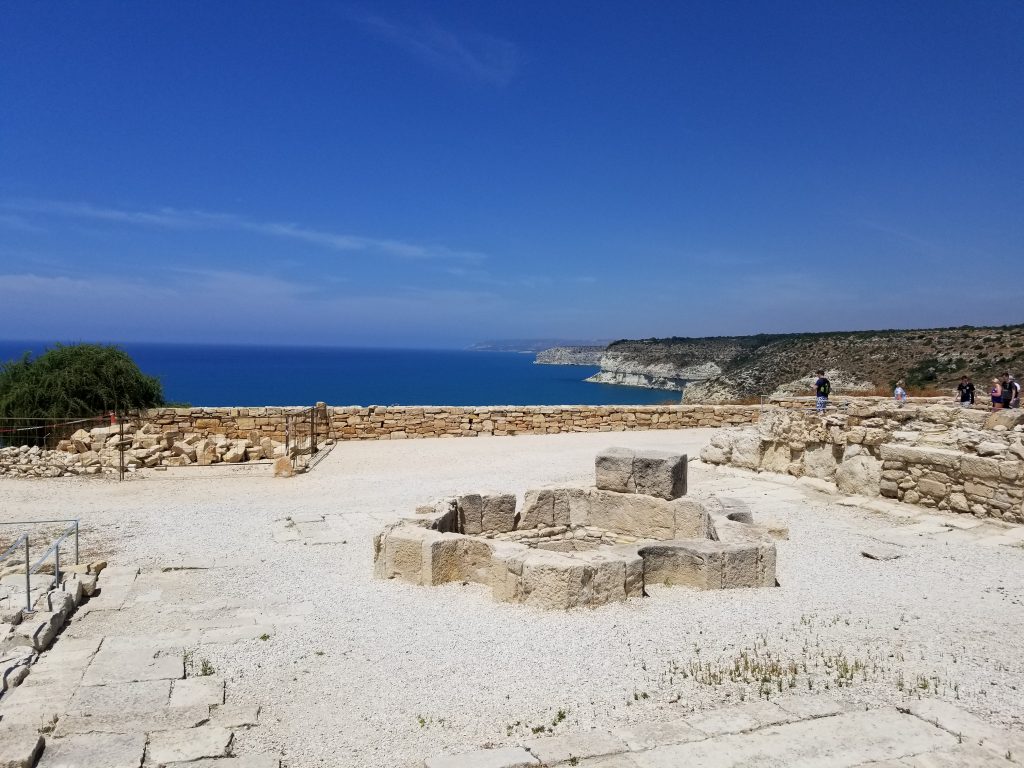Monday and Tuesday of this week were work days, and we’ve made some exciting progress in the trenches. An update on the archaeological work will come later this week. In addition to work in the field, however, the field school includes several required and optional trips to archaeological sites on Cyprus.
Staff and students generally work in the field five days a week, depending on the shooting schedule. Sundays are always free days, although this past Sunday many students took an optional trip to the nearby sites of Kourion and Amathus.

Kourion, located west of the major modern city of Limassol on Cyprus’ south coast, was one of the most important cities on the island from the early iron age through the late Roman period. Though we know from texts, coins, and archaeological evidence from the surrounding area that the site was important by as early as 800 BCE, most of the visible remains date to the later Roman period (4th to 7th century CE). This is common of ancient Mediterranean cities. People tended to inhabit the same areas for long periods of time, building on top of or replacing previous structures. This continuous occupation can make the identification of the earliest phases of occupation difficult to identify. Additionally, archaeology is destruction, and revealing chronologically earlier layers requires destroying later ones. No one really wants to destroy something like this.

Kourion contains many fine examples of late Roman mosaics, wealthy houses, bath complexes, and churches. Many buildings also provide evidence of damage caused by devastating earthquakes in the late fourth century, and subsequent repairs or replacement with newer buildings. Evidence about these processes of urban change are as important to archaeologists as any object or structure.

After Kourion and lunch at a restaurant on the beach, we headed to Amathus, an important sanctuary to Aphrodite to the east of modern Limassol. Cyprus is famously the “Island of Aphrodite,” as is evident in its tourism marketing, but the cult of Aphrodite at Amathus reveals the island’s complicated cultural history.
The site of Amathus, unlike Kourion, does preserve significant early remains dating to the archaic period (7th century BCE). After a strenuous climb to the top of the city’s acropolis, you are rewarded with the remains of a sanctuary to “Aphrodite.” In fact, a number of female deities, whose identities shifted over time, were honored here. The archaic sanctuary was marked by two enormous monolithic stone vases, while on top of this a Hellenistic portico and then a large Roman-style temple were later built, both of which incorporated the existing stone vases into their design. In fact, the vases even stood in the courtyard of the Christian church that was built on the same site. A copy of the intact stone vase, the original of which is now in the Lourve, stands amidst the broken remains of the second vessel.

It was a long day for a “day off.”
Wednesday was a shooting day, so we took the opportunity to take a required trip to Nicosia, the capital of Cyprus and the location of the primary archaeological museum on Cyprus. The Cyprus Museum enables a visitor to get an encyclopedic understanding of Cypriot material culture from the neolithic through the Roman period. Highlights include the contents of the Royal Tombs of Salamis, a bronze statue of the Roman emperor Septimius Severus, and a significant portion of the thousands clay votive figures found at the Agia Irini sanctuary. A visit to this museum is meant to give students perspective on the material they’re excavating and a sense of how it fits into Cypriot material culture.

After their time at the museum, the students had time to explore the old center of Nicosia. It was extremely hot, so no one seemed to be too sad to not be digging today.

